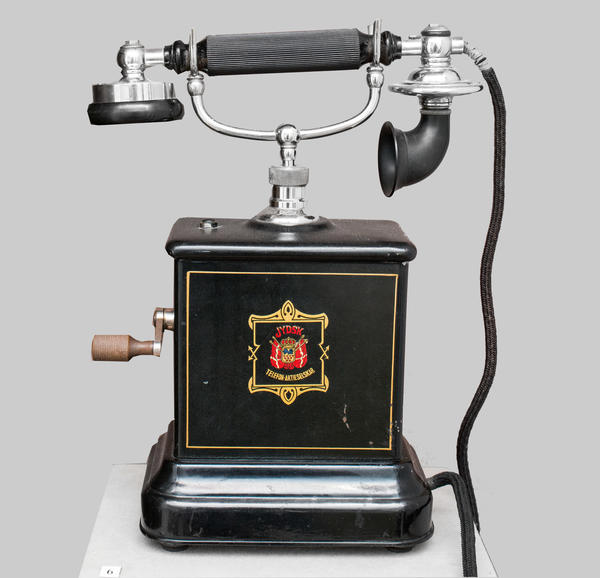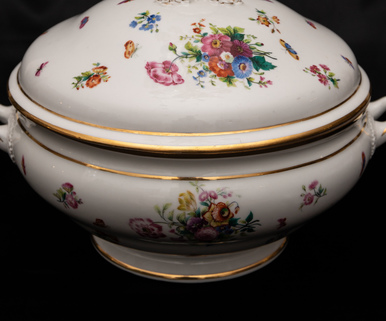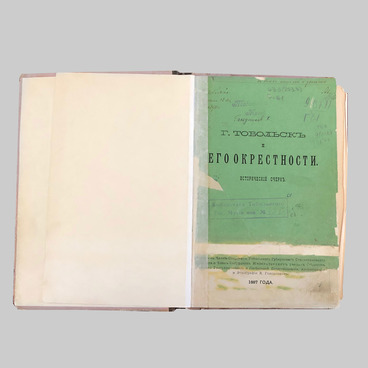The Museum of the Family of Emperor Nicholas II keeps a desktop diskless telephone with induction call. At the beginning of 20th century, phone calls were placed through telephone exchange operators. To do this, the caller was to turn the handle, the inductor generated current, and the phone started functioning. The call was passed through to station operator, who then connected interlocutors.
At the end of the 19th century, Emil Möllers Telephone Factory started manufacturing telephones in the Danish city of Horsens. The founder of production, Emil Möllers, was a successful manufacturer. Contemporaries recalled him as a very punctual and orderly person: the entrepreneur never wore a watch, but always arrived on time. He didn’t even use the alarm clock, but woke up at the right time. Later, the company changed its owners and its name several times.
The company produced models of devices, similar to the museum exhibit, from 1900 to 1920. The telephone from museum collection was manufactured in 1904. It was the cooperation with a Swedish company that enabled Danish manufacturers to sell their products in the Russian Empire. In 1900, Russian Imperial Post Office announced new tenders for servicing telephone networks in the country. They were won by Swedish-Danish-Russian Joint Stock Company, which was headed by Swedish telephone master Lars Magnus Ericsson and famous jeweler Henrik Torsten Södergren.
Lars Magnus Ericsson telephone factory opened in Russia in 1897. Its workers later built a central telephone exchange with 60,000 numbers at Milyutinsky Lane in Moscow. Telephone was installed in Kremlin in preparation for the visit of Nicholas 2nd to Moscow. By 1917, the factory became Ericsson’s largest manufacturing enterprise. It employed 3,500 workers, twice as much as the company’s main factory in Stockholm. In January 1917, Moscow city telephone network was transferred to the Soviet government by contract. The Swedish-Danish-Russian Joint Stock Company got no compensation. The plant later became known as Krasnaya Zarya.
At the end of the 19th century, Emil Möllers Telephone Factory started manufacturing telephones in the Danish city of Horsens. The founder of production, Emil Möllers, was a successful manufacturer. Contemporaries recalled him as a very punctual and orderly person: the entrepreneur never wore a watch, but always arrived on time. He didn’t even use the alarm clock, but woke up at the right time. Later, the company changed its owners and its name several times.
The company produced models of devices, similar to the museum exhibit, from 1900 to 1920. The telephone from museum collection was manufactured in 1904. It was the cooperation with a Swedish company that enabled Danish manufacturers to sell their products in the Russian Empire. In 1900, Russian Imperial Post Office announced new tenders for servicing telephone networks in the country. They were won by Swedish-Danish-Russian Joint Stock Company, which was headed by Swedish telephone master Lars Magnus Ericsson and famous jeweler Henrik Torsten Södergren.
Lars Magnus Ericsson telephone factory opened in Russia in 1897. Its workers later built a central telephone exchange with 60,000 numbers at Milyutinsky Lane in Moscow. Telephone was installed in Kremlin in preparation for the visit of Nicholas 2nd to Moscow. By 1917, the factory became Ericsson’s largest manufacturing enterprise. It employed 3,500 workers, twice as much as the company’s main factory in Stockholm. In January 1917, Moscow city telephone network was transferred to the Soviet government by contract. The Swedish-Danish-Russian Joint Stock Company got no compensation. The plant later became known as Krasnaya Zarya.



